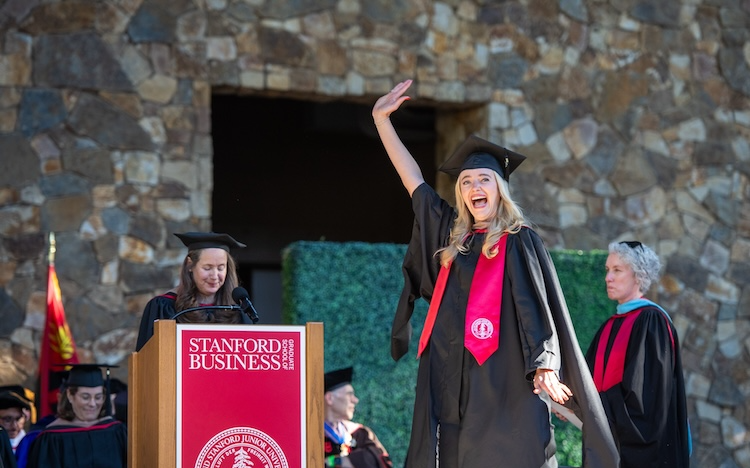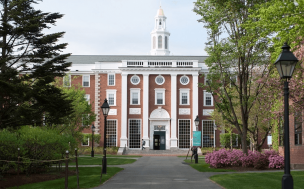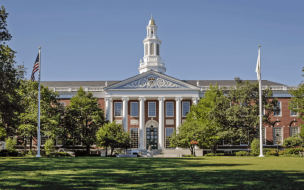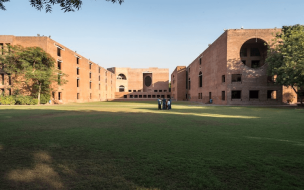If you’re applying to an MBA program at one of the world’s top business schools, you’ll want to know the MBA acceptance rates.
Acceptance rates are the percentage of applicants who are admitted into an MBA program. They tell you how competitive a school is and how likely your MBA application is to be successful.
Applying for a top MBA program?
Download our free MBA Application Guide
Stanford’s MBA acceptance rate is 8.4% on average, making Stanford the world’s most competitive MBA program. The most recent data shows 6,190 people applied to the full-time MBA at Stanford Graduate School of Business but only 521 got accepted.
Fewer still enrolled in the Stanford MBA class—only 431 (an impressive enrollment rate of 82.7%). Schools will always admit more candidates than they enroll, with many accepting offers from other schools or dropping out.
BusinessBecause has used data from the US News Report and other available sources to break down the MBA acceptance rates at top schools—including the M7 business schools.

MBA Acceptance Rates for top business schools
Compared to last year, the current application cycle is expected to be a similar level of competitiveness or slightly down.
David White, founding partner and admissions consultant from Menlo Coaching says, “For the 2024/2025 cycle, I anticipate that application volume will be similar to...
The M7 business schools received an average of 5,683 MBA applications in the latest numbers. With the average class size of these schools at 646 for the intake, only a select number of applicants are admitted, with their applications, essays, and GMAT scores scrutinized by admissions teams before a final interview.
The average MBA acceptance rate for the M7 business schools is 21.8%.

After Stanford, Harvard, the MBA with the highest number of applicants, boasts the next most competitive MBA acceptance rate, at 11.5%. 5,317 people applied to the MIT Sloan MBA, and while 947 got accepted only 409 enrolled (an enrolment rate of 43.2%).
More business schools with competitive MBA acceptance rates include Duke Fuqua (22.1%), Columbia (22.4%) and Berkeley: Haas (23%).
Wharton, the world’s number one MBA according to the FT 2024 ranking, has an acceptance rate of 24.8% and the Yale MBA’s acceptance rate is a relatively encouraging 32.9%.
Business schools with less competitive acceptance rates include UCLA Anderson, at 40.4% as well as McCombs School of Business at 37.9%.
While MBA acceptance rates tend to be most competitive at the top US schools and are sometimes seen as an indicator of program demand and value, they don’t tell you about the quality of the candidates applying.
To assess the quality of the MBA class, you’re better off looking at class average GMAT scores or GMAT score ranges.
While the MBA acceptance rate is the percentage of applicants admitted into the program, the MBA enrolment rate is the percentage of those who are accepted actually enroll.
Enrollment rates are less useful in assessing how competitive each school is due to the drop off in accepted candidates, but comparing acceptance and enrollment rates can provide interesting insights into how candidates view schools.
Harvard’s MBA enrollment rate, the highest at 87.2%, is consistent with its high number of applicants and competitive acceptance rate. However, Berkley Haas and Virginia Darden record significantly lower enrollment rates (36.6% and 31.5% respectively).
This means a significant number of candidates who were accepted into those schools ultimately chose not to enroll. Most likely, they decided to defer or chose alternative schools.
The high percentage of Stanford and Harvard’s enrollment rates demonstrates the popularity of them compared with other schools. Of the 521 students admitted to Stanford, only 90 did not enroll, while of the 1,076 accepted to Harvard 938 enrolled. (In short, if you get an offer from Stanford or Harvard, you most likely take it!)
MBA acceptance rates at the top business schools in the US
Last year a larger number of global business schools reported an increase in applications in 2023 than last year, according to the Graduate Management Admissions Council (GMAC) Application Trends Survey, and this upwards trend is likely to continue into this year.
However, while this would seem to indicate a more competitive cycle, business school applications are being spread across a greater variety of programs schools.
As GMAC’s Application Trends survey showed, among the schools reporting an uptick, it was the more flexible programs such as hybrid and part-time degrees that were most likely to see an increase. This was also true for business schools with less selective admissions policies.
Looking ahead to the publication of GMAC’s Application Trends Survey this autumn, Andrew Walker, director of research analysis and communications at the Graduate Management Admission Council, predicts a similar trend.
He states that studying while working is becoming an increasingly common way to earn an MBA. He adds that applications to top-tier, full-time programs that saw declines in 2023 might bounce back this year.
“We’ve recently seen more applicants are willing to sacrifice prestige in favor of greater flexibility, but early signs indicate a rebound for more traditional programs, too,” says Andrew.
If you’re considering applying to one of these top MBA programs this year, download our free BusinessBecause MBA Application Guide | How To Land Your Place For 2025
Register for free to continue reading
RECAPTHA :
f5
b6
e9
b7














The best of our Premium Articles